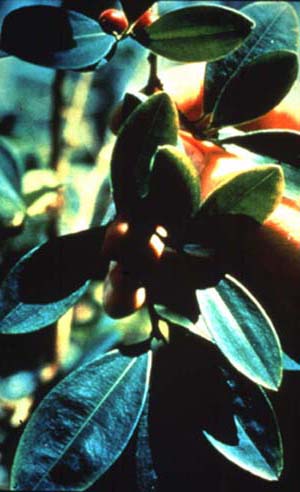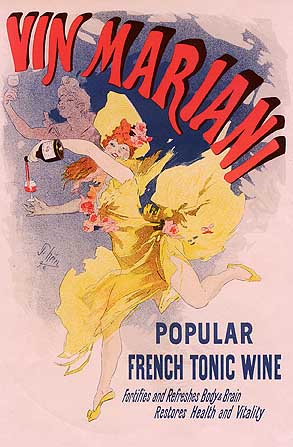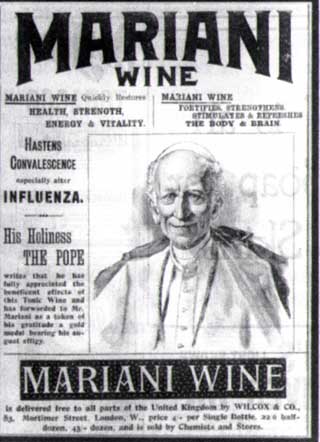| Home |
| History and uses of the Coca leaf |
| Other uses of coca, including the production of cocaine |
| The Drug Trade |
| Drug Wars |
| Bibliography |
| Andean History |
History and uses of the Coca leaf
The Coca Plant

Coca shrubs grow wild in much of South America, growing
to heights of 12 to 18 feet, although cultivated plants are usually kept
at about 6 feet.There are over one
hundred species of coca shrubs although only two are used for chewing.One
called the Bolivian leaf (Erythroxylon coca) and the other known as the
Peruvian leaf (Erythroxylon novogranatense).This
plant is resistant to drought and disease, and doesn’t need irrigation.The
delicate tea-like leaves of the coca plant can be harvested four times
a year for almost 50 years.Coca
grows best in the moist climate of the Andes mountains at elevations of
4,500 to 6,000 feet.
Early Myths and Legends
Early South American folklore accredits the appearance of coca to different deities.One of the earliest known legends on the origin of coca was recorded by investigators of the Viceroy Toledo in 1571 in their Informacion of Inca history:
“In answering questions about the shrub, the aged Indians invariably told the same story.From what they had heard, the Indians recalled, before coca was a shrub it was a beautiful woman.Discovered to be an adultress, she was executed, cut in half, and buried as a seed would be planted.From part of her severed body, a shrub, which became known as ‘macoca’ and ‘coca-mana,’ began to grow and blossom.Only men were permitted to pick its leaves, placing them in their pouches.It was soon learned that the pouches could be opened to take coca only after copulation, which was to be performed in the memory of the beautiful but dismembered adultress”(Phillips, 5).
Freud cited a legend of the Aymaran tribe in which
Khuno, the god of snow and storm, angrily burned the land of all vegetation
but the coca plant.The Indians ate
the leaves to relieve their hunger, and found that it also helped them
endure the cold.Two other legends
come from the Inca period attributing divine origin to the plant.According
to one legend, the plant was a gift from the sun god Inti who instructed
the moon mother Moma Quilla to plant the coca in the moist valleys of the
Andes.It was to only be used by
the Incas, as they were the descendants of the gods, to give them endurance
to perform their earthly functions.The
other and more famous legend involves Manco Capac, the son of god and his
sister-wife Mama Oello the founders of the Inca empire.Legend
says that they brought the culture of agriculture and the made the coca
plant a present to the Incans for their hard labor.It
was considered a divine plant which satiates the hungry, strengthens the
weak, and causes those who chew it to forget their misfortunes.
Early Uses
 Coca
leaves have been chewed by South American Indians for many thousands of
years to induce a mild, long-lasting euphoria.The
Incas venerated coca.They used
it in magical ceremonies and initiation rites.In
the Inca period, the sacred leaf was regarded as far too good for ordinary
Indians.The invading Spanish conquistadors
were more practical.They were impressed
at coca’s efficacy as a stimulant.They
believed that the herb was so nutritious and invigorating that the Indians
labored whole days without anything else.The
Spanish also needed native labor in their silver mines.Work
in the mines was extremely arduous, and taking coca reduces appetite and
increases physical stamina.Therefore
there was a great surge in coca use and the number of coqueros (coca-chewers).
Coca
leaves have been chewed by South American Indians for many thousands of
years to induce a mild, long-lasting euphoria.The
Incas venerated coca.They used
it in magical ceremonies and initiation rites.In
the Inca period, the sacred leaf was regarded as far too good for ordinary
Indians.The invading Spanish conquistadors
were more practical.They were impressed
at coca’s efficacy as a stimulant.They
believed that the herb was so nutritious and invigorating that the Indians
labored whole days without anything else.The
Spanish also needed native labor in their silver mines.Work
in the mines was extremely arduous, and taking coca reduces appetite and
increases physical stamina.Therefore
there was a great surge in coca use and the number of coqueros (coca-chewers).
Coca has been
used for ages as a food substitute, a stimulant, a medicine, as an aphrodisiac,
a means to stay warm, and as a measure of distance.An
important factor in the spread of coca-chewing among Indians was due to
a need for a food substitute when the Incan agricultural economy broke
down due to inter tribal wars.Nutritional
analysis shows that 100 grams of coca leaves contain 305 calories, 18.9
grams of protein, and 46.2 grams of carbohydrates, and satisfies the recommended
dietary allowances for calcium, iron, phosphorus, and vitamins A, B, C,
and E (Phillips, 15).As a medicinal
herb, coca has been used in treating a variety of ailments and diseases.Generally
applied by shaman or medicine men, they are applied in rites and ceremonies.Studies
show that coca have peripheral vasoconstrictive effects that reduces the
amount of heat loss through the extremities and produces a higher central
body temperature keeping the user warmer.Coca
was also used a measurement of distance or the time it took to chew a quid
of coca, the equivalent of about forty minutes of two level miles.
Manner of Use
The
chewing of coca is a well-defined practice that has changed little over
the centuries.First, the coquero
takes several coca leaves from a chuspa, a baglike container.The
midribs of the leaves are removed and placed in the side of the mouth.More
leaves are added until a quid or plug is formed.From
a poporo, a small container carried in or attached to the chuspa, a limestone
substance is removed and added to the quid in the mouth.Coca
de mate a tea made from the leaves is also popular.Drinking
coca tea tends to soothe the stomach and is good for digestive problems.

Vin Mariani


Mariani used a variety of celebrities to endorse his
product including:Fredric Auguste
Bartholdi (statue of liberty sculptor), Anatole France, Henrik Ibsen, Jules
Verne, Alexander Dumas, Sir Arthur Conan Doyle, and Robert Louis Stephenson
(all writers).Vin Mariani was also
celebrated by royal and religious figures including:Queen
Victoria, King George, The Grand Rabbi of France Zadoc Kahn, Pope Pius
X, and Pope Leo XIII.President
McKinley was also reported to having used it.
Coca-Cola
 John
Styth Pemberton of Atlanta Georgia, a chemist came up with the world famous
Coca Cola. He based his original drink on Vin Mariani. 'Pemberton's
French wine coca' proved to be very popular with Americans. When
Atlanta introduced Prohibition in 1886, Pemberton had to replace the wine
in his recipe with sugar syrup, and the wine became 'Coca-Cola: the temperence
drink'. In 1904, America's concern about drug abuse led the manufacturers
to remove the cocaine from Coca-Cola. Until 1904 the typical serving
contained around 60mg of cocaine. Sold today, it still contains an
extract of coca-leaves, importing eight tons a year, however there is no
drugs in it. Visit Coca-Cola's web page at: http://www.thecoca-colacompany.com/.
John
Styth Pemberton of Atlanta Georgia, a chemist came up with the world famous
Coca Cola. He based his original drink on Vin Mariani. 'Pemberton's
French wine coca' proved to be very popular with Americans. When
Atlanta introduced Prohibition in 1886, Pemberton had to replace the wine
in his recipe with sugar syrup, and the wine became 'Coca-Cola: the temperence
drink'. In 1904, America's concern about drug abuse led the manufacturers
to remove the cocaine from Coca-Cola. Until 1904 the typical serving
contained around 60mg of cocaine. Sold today, it still contains an
extract of coca-leaves, importing eight tons a year, however there is no
drugs in it. Visit Coca-Cola's web page at: http://www.thecoca-colacompany.com/.